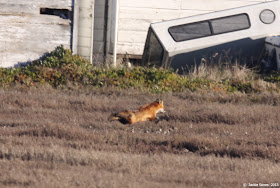This looks like a Red Fox (Vulpes vulpes). Note the dominant red coloration above, white underparts, black legs, relatively long muzzle, and the bushy tail held horizontally when running.
Some Red Foxes have white tips to their tails, others don't. I only had a few seconds and a few photos, but I couldn't really see white on the tail of this individual.
There are some interesting and somewhat complicated stories about Red Foxes in California. This is what I've learned so far. There are both native and non-native (introduced) Red Foxes in the state.
The native foxes are subspecies that live either in the mountains (Sierra Nevada Red Fox, Vulpes vulpes necator) or valley grasslands (Sacramento Valley Red Fox, Vulpes vulpes patwin).
The introduced foxes are broader in their habitat use and probably originated from either fur farms (common in the mid-1900s) or releases for hunting (starting in the late 1800s; they were imported from eastern Canada and Alaska).
Because Bodega Bay is neither in the mountains or in the Central Valley, this fox is most likely an introduced fox. (You'd have to sample its DNA to tell for sure.) From what I can gather, introduced Red Foxes are found along the coast from Sonoma County to San Diego County, but it sounds like they're rather rare in coastal areas of Sonoma and Marin counties.
Peter Connors recorded a handful of Red Fox observations in the Bodega Bay area in 1979 and in the 1980s. I'm not sure how many have been seen since then. If you think you've seen a Red Fox, it'd be great to hear about it!
Here's another image showing the dark legs. The fox was bounding across the marsh, so the legs are outstretched.
To compare with the other more common local canids, review the posts on the smaller and grizzled Gray Fox and the much larger and blonder Coyote.



We have seen a red fox many times in our yard outside Petaluma. I have a few bad photos from 9/10/12 that show it has a white-tipped tail.
ReplyDeleteApparently the normal ambulatory mode in salt marshes for red foxes is floating.
ReplyDelete